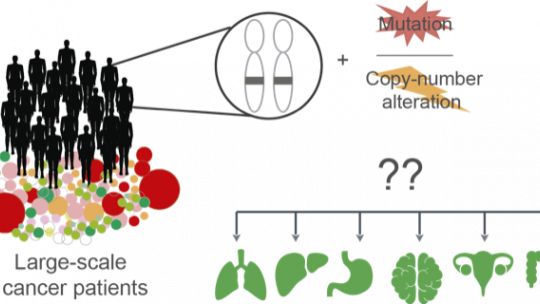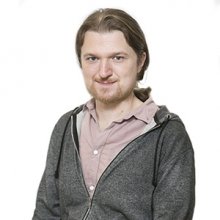Images
The finding is equivalent to discovering a new 'grammatical rule' in genetic language, one explaining why the same mutation sometimes gives rise to cancer and sometimes does not.
This is the first time that the landscape of third-order interactions has been characterized in cancer.
The authors analyse the interactions between genetic alterations present in 10,000 human tumors.
The language in which the DNA book of life is written is still being deciphered, which is why it remains a challenge to translate what genes say into physical traits in the organism. For example, why does this or that mutation sometimes cause cancer, and sometimes not? Researchers at the CNIO, the CRG and the IRB Barcelona have just discovered one of the reasons: the power of a mutation depends on its interaction with another, and often even on the relationship between this pair of mutations with a third.
This is the first time that the landscape of third-order interactions has been characterized in cancer.
Their finding is equivalent to revealing one of the grammatical rules of genetic language, a rule saying that −following the metaphor of writing−, the same word (mutation) has different meanings depending on the other words in the sentence, and on the context in which it appears.
The study, led by Dr. Solip Park, Head of the Computational Cancer Genomics Group at the CNIO, is co-authored by Dr. Ben Lehner, ICREA Research Professor at the CRG (Center for Genomic Regulation) and Dr. Fran Supek, ICREA Reseaerch Professor at the IRB Barcelona (Institute for Research in Biomedicine). It has just been published in Nature Communications.
As Dr. Park states, "this is the first systematic, in-depth, multi-data analysis of the interactions between genetic alterations involved in cancer. There are several works that study a single gene or a single type of cancer, but this is the first large-scale systematic one."
Medium-term clinical implications
The research opens the way to deciphering the functioning of the half thousand or so mutations known to be involved in cancer. If successful, the clinical implications would be significant. Genetic diagnosis would be more precise and new therapeutic targets could be sought, since the best way to counteract a given mutation could be by acting on another.
"So far, research has tended to focus on alterations in a single gene that can be targeted with drugs, but this approach means that associations between different genes involved in cancer must be considered," explains Dr. Park.
Data from 10,000 tumors
Researchers in cancer genetics have known for years that this disease results, in the vast majority of cases, from different genetic alterations acting at the same time. But only now, with big data techniques and great computational power, has it been possible to tackle the challenge of deciphering these interaction networks.
The authors of the paper, computational biologists, turned to The Cancer Genome Atlas (TCGA). They analyzed the interactions between the genetic alterations in 10,000 human tumors of about 30 different types, affecting more than 200 genes.
The hypothesis on how cancer genes are activated is not correct
By analyzing the interactions between genetic alterations the authors dismantle one of the most widely accepted hypotheses on how genes that promote tumor development are activated. This is the so-called two-hit model.
An oncogene promotes cancer when it is activated, while a tumor suppressor gene acts the other way around; it is its inactivation that drives cancer. "The classic theory," explains Dr. Park, "is that a single mutation in an oncogene can be enough to promote cancer, whereas for a tumor suppressor gene to act, inactivation of both copies of the gene, the father's and the mother's, is required. This is the 'two-hit' hypothesis. But many exceptions to this classic model are coming to light, and this work finds an explanation."
Their analysis of the networks of interactions between genetic alterations in 10,000 tumors reveals that many genes involved in cancer, whether oncogenes or tumor suppressor genes, may require one or two hits depending on what other mutations are at work.
Cancer is reached by several pathways
"The correct genetic model for a gene thus depends on the other mutations in the genome," write Drs. Park, Lehner and Supek. "A second hit in the same gene, or an alteration in a different gene in the same pathway, represent alternative evolutionary pathways to cancer."
In other words, we must not only take into account the effects of individual mutations or pairwise interactions, “but also what happens when three or more alterations are combined," adds Dr. Park.
The researchers postulate that this new grammatical rule of genetic language is universal, i.e., not just involved in cancer. "These principles of genetic architecture are likely to apply to other diseases as well. We believe that systematically analyzing higher-order genetic interactions may also help to understand the molecular mechanisms that cause other human diseases ," the authors note.
Related article:
Higher order genetic interactions switch cancer genes from two-hit to one-hit drivers
Solip Park, Fran Supek and Ben Lehner
Nature Communications (2021) DOI: 10.1038/s41467-021-27242-3
About IRB Barcelona
The Institute for Research in Biomedicine (IRB Barcelona) pursues a society free of disease. To this end, it conducts multidisciplinary research of excellence to cure cancer and other diseases linked to ageing. It establishes technology transfer agreements with the pharmaceutical industry and major hospitals to bring research results closer to society, and organises a range of science outreach activities to engage the public in an open dialogue. IRB Barcelona is an international centre that hosts 400 researchers and more than 30 nationalities. Recognised as a Severo Ochoa Centre of Excellence since 2011, IRB Barcelona is a CERCA centre and member of the Barcelona Institute of Science and Technology (BIST).






